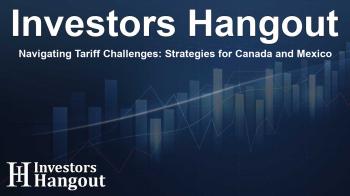Navigating Tariff Challenges: Strategies for Canada and Mexico

Understanding Potential Tariffs on Canada and Mexico
As the U.S. considers a significant 25% tariff on imports from neighboring countries, Canada and Mexico find themselves at a crossroads. The looming tariffs could lead to extensive economic consequences, igniting fears of a trade war that would affect not just the U.S., but also its closest trading partners.
The Economic Interdependence
The interconnected nature of these economies highlights their vulnerability to trade disruptions. A staggering 30% of Canada's GDP and an even larger 40% of Mexico's GDP hinge upon their trade relationships with the United States. This heavy reliance makes the potential tariffs a critical concern for both nations.
Analyzing the Tariff Effects
Analysts emphasize that should these tariffs be enacted, they might provoke retaliatory measures from Canada and Mexico. As trade becomes strained, the economic fabric of all three countries could be severely tested. BofA Securities warns that the situation calls for careful navigation to avoid an unmanageable trade conflict.
Monetary Policy Responses
The Bank of Canada and the Bank of Mexico face unique challenges in maneuvering through the financial turbulence that tariffs could bring. Currently, the Bank of Canada appears more flexible, potentially poised to ease monetary policy through rate cuts due to stable inflation levels.
The Bank of Canada's Options
With Canada's inflation rate resting around the target of 2%, the Bank of Canada could lessen interest rates to bolster economic resilience. Such measures could also devalue the Canadian dollar, providing a buffer against diminishing export competitiveness.
Challenges for Mexico's Central Bank
In contrast, the Bank of Mexico contends with significant constraints, chiefly higher inflation rates that surpass its targets. With headline inflation at 4%, its capacity to reduce rates is severely restricted. This predicament leaves Mexico's economy exposed to external shocks without the same monetary policy levers as Canada.
Future Projections
As economic analysts project, the Bank of Mexico may adopt a conservative approach to interest rates, with modest reductions being cautiously integrated into forecasts further down the road. This gap in monetary policy flexibility between the two nations adds another layer of complexity to their economic responses.
Potential Retaliations and Diplomatic Efforts
In light of the proposed tariffs, both nations face potential retaliatory tariffs, which could escalate tensions. However, diplomatic engagements may offer a more stable resolution. Mexico has demonstrated a willingness to engage with the U.S. by imposing its own tariffs on imports from China, an effort to alleviate any concerns of being a conduit for Chinese goods.
Collaborative Approaches
Canada and Mexico are also working collaboratively to address concerns related to drugs and illegal immigration, which are often cited in negotiations involving U.S. tariffs. By aligning their strategies and reinforcing mutual interests, both nations aim to mitigate any long-term impacts of proposed tariffs.
The Path Forward
Ultimately, the response strategy for Canada and Mexico hinges on a delicate balance between measured retaliation and proactive diplomacy. While the potential for tariffs seems to loom, fostering economic stability should remain their primary focus. Strengthening trade relations with the U.S. serves as the most effective avenue to enhance long-term prosperity for both nations.
Frequently Asked Questions
1. What are the potential impacts of U.S. tariffs on Canada and Mexico?
The proposed tariffs could lead to a trade war, severely impacting economic stability and trade relationships among the three countries.
2. How does the Bank of Canada plan to respond to these tariffs?
The Bank of Canada may ease monetary policy through interest rate cuts to support the economy if tariffs are imposed.
3. What challenges does the Bank of Mexico face?
The Bank of Mexico struggles with higher inflation above its targets, limiting its ability to engage in significant rate cuts.
4. Are retaliation measures expected from Canada and Mexico?
Yes, both countries may consider retaliatory tariffs, but a focus on diplomacy could yield better long-term results.
5. How interconnected are the U.S., Canada, and Mexico economically?
Approximately 30% of Canada's GDP and 40% of Mexico's GDP depend on trade with the U.S., indicating strong economic ties.
About The Author
Contact Henry Turner privately here. Or send an email with ATTN: Henry Turner as the subject to contact@investorshangout.com.
About Investors Hangout
Investors Hangout is a leading online stock forum for financial discussion and learning, offering a wide range of free tools and resources. It draws in traders of all levels, who exchange market knowledge, investigate trading tactics, and keep an eye on industry developments in real time. Featuring financial articles, stock message boards, quotes, charts, company profiles, and live news updates. Through cooperative learning and a wealth of informational resources, it helps users from novices creating their first portfolios to experts honing their techniques. Join Investors Hangout today: https://investorshangout.com/
The content of this article is based on factual, publicly available information and does not represent legal, financial, or investment advice. Investors Hangout does not offer financial advice, and the author is not a licensed financial advisor. Consult a qualified advisor before making any financial or investment decisions based on this article. This article should not be considered advice to purchase, sell, or hold any securities or other investments. If any of the material provided here is inaccurate, please contact us for corrections.

